Samsung soundbars are renowned for their excellent audio quality and sleek design, making them a popular choice for enhancing the audio experience of modern televisions. However, like any electronic device, they can encounter connectivity issues. If your Samsung soundbar is not connecting to your TV, it can be frustrating, but don’t worry; there are several potential reasons and solutions for this problem.
In this comprehensive troubleshooting guide, we’ll explore the common issues that may prevent your Samsung soundbar from connecting to your TV and provide step-by-step solutions to help you get your audio setup back on track.
Check the Basics
Let’s start with the basics before diving into more complex troubleshooting steps. Verify that you’ve covered the fundamental aspects of connecting your Samsung soundbar to your TV:
Power: Ensure your soundbar and TV are adequately powered on. Check power cables and switches if applicable.
Cables: Examine the audio cables (HDMI, optical, or other) connecting your soundbar to your TV. Look for any visible damage to the cables, connectors, or ports.
Input Source: Confirm that the input source on your TV matches the one you’ve connected your soundbar to. This is essential for the TV to recognize and output audio through the soundbar.
Volume Settings: Ensure that the volume on both your soundbar and TV is set to an audible level. Sometimes, one of the devices may be muted or assigned to a very low volume.
Verify Compatibility
Samsung soundbars are designed to be compatible with a wide range of TVs, but it’s essential to verify that your TV supports the connection method you’re using. The most common audio connection methods are HDMI ARC (Audio Return Channel), optical audio, and Bluetooth. Check if your TV has the necessary ports and supports the chosen connection type.
HDMI ARC Troubleshooting
HDMI ARC is a popular and convenient way to connect your Samsung soundbar to your TV, as it allows for both audio transmission and control over a single HDMI cable. If you’re using HDMI ARC and encountering issues, follow these steps:
Check HDMI ARC Port: Ensure your TV and soundbar are connected to HDMI ARC-compatible ports. These ports are often labeled “ARC” and may have specific icons.
Enable HDMI ARC on Your TV: Access your TV’s settings menu and navigate to the audio or HDMI settings. Find the option to enable HDMI ARC. Depending on your TV model, this option may be labeled differently.
Enable HDMI CEC: HDMI CEC (Consumer Electronics Control) allows devices connected via HDMI to communicate and control each other. Enable HDMI CEC on your TV and soundbar if available. This ensures that they work seamlessly together.
Check HDMI Cable: Use a high-quality HDMI cable to connect your soundbar to your TV. If the cable is damaged or not functioning correctly, it can disrupt the connection.
Power Cycle Devices: Turn off your TV and soundbar, unplug them from the power source, and wait a minute or two. Then, plug them back in and power them on. Sometimes, this simple reset can resolve HDMI ARC issues.
Update Firmware: Visit the Samsung website to check if firmware updates are available for your soundbar and TV. Updating the firmware can address compatibility issues and improve performance.
Optical Audio Troubleshooting
If you’re using an optical audio cable to connect your Samsung soundbar to your TV, follow these steps to troubleshoot any issues:
Verify Optical Cable: Ensure that the optical audio cable is securely connected to both the soundbar’s optical input and the TV’s optical output. Optical cables use a square-shaped connector that should fit snugly.
Select the Optical Audio Source: Select the optical audio source or input on your soundbar. Many Samsung soundbars have a dedicated button on the remote control or soundbar for this purpose.
TV Audio Settings: Access your TV’s audio settings and choose the optical audio output as the audio source. This may involve navigating through your TV’s settings menu to select the appropriate audio output.
Check Optical Cable: Inspect the optical cable for damage, kinks, or bends. Optical cables are sensitive to physical damage, which can disrupt the audio signal.
Try a Different Optical Cable: If you suspect a faulty optical cable, try a different one to rule out cable-related issues.
Update Firmware: As with HDMI ARC connections, check for firmware updates for both your soundbar and TV. Installing the latest firmware can address compatibility issues.
Bluetooth Troubleshooting
Bluetooth connectivity allows you to connect your Samsung soundbar to your TV wirelessly. If you’re experiencing issues with Bluetooth, follow these steps:
Pairing: Ensure that your soundbar and TV are correctly paired. Refer to the user manuals of both devices for instructions on how to pair them via Bluetooth.
Check Range: Bluetooth is limited, typically around 30 feet (10 meters). Make sure your TV is within this range of the soundbar. Obstructions like walls can also affect Bluetooth signals.
Clear Pairing List: If you’ve previously paired your soundbar with other devices, clear the pairing list on the soundbar and repair it with your TV.
Bluetooth Version: Check the Bluetooth versions your soundbar and TV supports. Some older devices may have limited Bluetooth compatibility.
Interference: Bluetooth signals can be disrupted by interference from other electronic devices. Ensure that there are no nearby devices causing interference.
Samsung Soundbar App
Samsung offers a dedicated app that allows you to control and configure your soundbar from your mobile device. The app can also assist in troubleshooting and setup. Here’s how to use the app for troubleshooting:
Download the App: Install the Samsung SmartThings or Samsung Audio Remote app on your smartphone or tablet.
Connect Your Soundbar: Ensure that your mobile device is connected to the same Wi-Fi network as your soundbar. Open the app and follow the on-screen instructions to connect to your soundbar.
Troubleshoot: Use the app’s troubleshooting or setup features to diagnose and resolve connectivity issues. The app can guide you through the necessary steps.
Firmware Updates: Check for firmware updates within the app and apply them if available. Firmware updates can address compatibility issues and improve performance.
Factory Reset
If you’ve tried all the troubleshooting steps and your Samsung soundbar is still not connecting to your TV, you can perform a factory reset as a last resort. Keep in mind that a factory reset will erase all custom settings and configurations, so you’ll need to set up your soundbar from scratch. Here’s how to perform a factory reset on a typical Samsung soundbar:
Ensure that the soundbar is powered on.
Press and hold the “Sound Control” button for about 5 seconds on the soundbar’s remote control.
The display on the soundbar will show “INIT” or “RESET,” indicating that the factory reset process has begun.
Release the “Sound Control” button.
Wait for the soundbar to complete the reset process. It will power off and then power back on.
Follow the initial setup instructions to configure your soundbar, including choosing the input source and pairing it with your TV if necessary.
Contact Samsung Support
If you’ve exhausted all the troubleshooting steps, and your Samsung soundbar is still not connecting to your TV, it may be time to reach out to Samsung’s customer support. They can provide further assistance, guide you through advanced troubleshooting, and, if necessary, arrange for repairs or replacements if your soundbar is under warranty.
When contacting support, provide detailed information about your soundbar model, TV model, connection type, and specific issues you’re experiencing. This will help the support team diagnose and address the problem more effectively.
Conclusion
A Samsung soundbar not connecting to your TV can be frustrating, but with patience and the right troubleshooting steps, you can often resolve it. Whether you’re using HDMI ARC, optical audio, or Bluetooth, the key is to check the basics, verify compatibility, and follow the specific troubleshooting steps for your connection method.
Remember to update firmware, use the Samsung Soundbar app for assistance, and consider a factory reset a last resort. If all else fails, don’t hesitate to contact Samsung support for expert assistance. With the right approach, you can enjoy the outstanding audio quality that Samsung soundbars are known for, seamlessly integrated with your TV.






